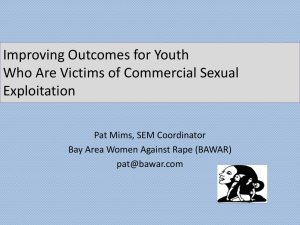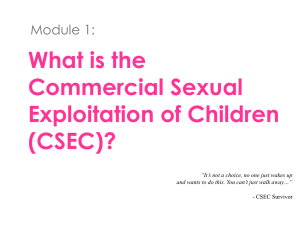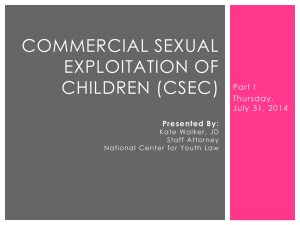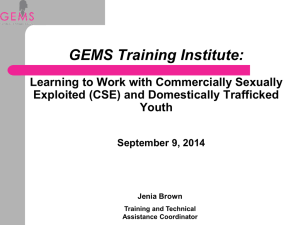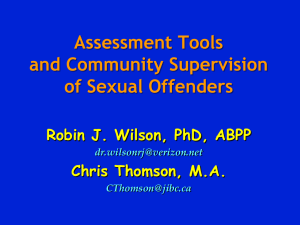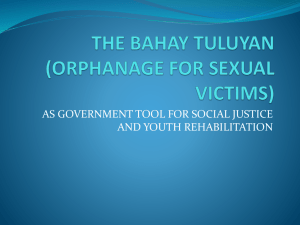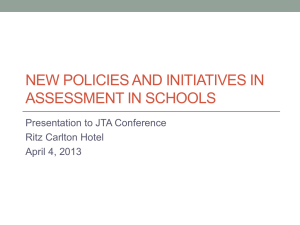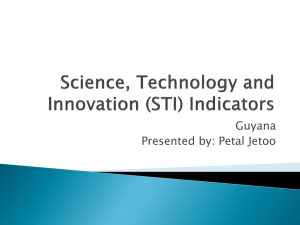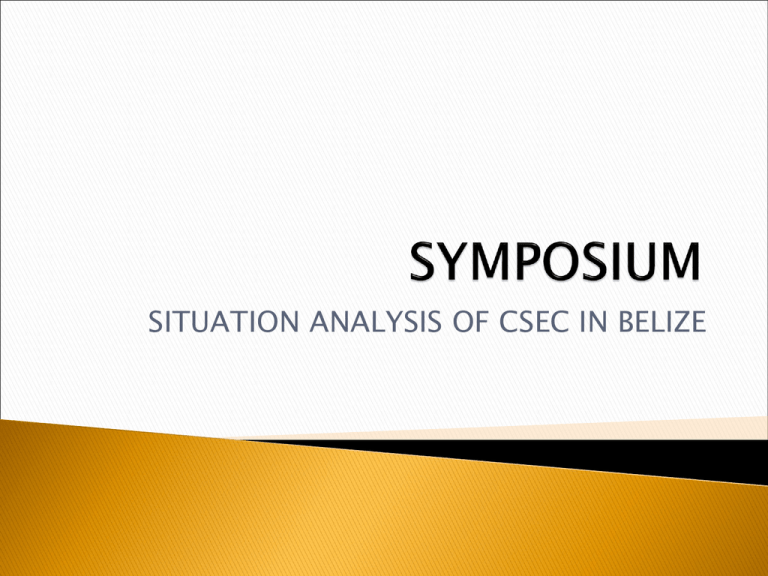
SITUATION ANALYSIS OF CSEC IN BELIZE
Literature review of studies, reports, laws and
policies addressing CSEC.
Focus group discussion of DHS social workers
involved in CSEC and trafficking.
Interview of youth regarding perception of
CSEC.
Interview of community activist involved with
working with victims.
2002 – Study on the Sexual Exploitation of Women and Children: Belize
2004 – Vulnerability Analysis of Children and Adolescents in Belize
2006 – The Commercial Sexual Exploitation of Children in Belize – only published
study on the subject
2006 – BTB/Rainforest Alliance sensitisation of hotel operators
2007 – Draft Law Bill prohibiting CSEC
2007 – 2009 – Pilot project with YES to remove 100 victims from CSEC activities
2008- Care Model Protocol for Stakeholders
2007 -2009 – Media campaign and public awareness; sensitisation of Police,
social workers, teachers and other stakeholders
2008-2009- ECPAT/BTB – sensitisation of resort operators
2008 – National Child Labour Policy – Labour Department initiative to address
CSEC one of the worst forms of child labour
2009 – DHS took over responsibility of victims from the pilot project and
appointed social worker to coordinate response.
CSEC remains one of the worst human rights violations facing children and
adolescents in Belize in 2010.
DEMOGRAPHICS AND LANGUAGE
◦ Preliminary findings of 2010 census – population of
350,000
◦ About one third of population is resident in Belize District
but majority of the population lives in rural communities
with a slight increase in urban centers since the last census
in 2000.
◦ Marked increase of migrant communities.
◦ The official language is English, however, Spanish is the
most spoken language .
◦ Belize is ethnically diverse with Hispanics being over 50%
of the entire population; Creoles over 25% ; Maya over 10%;
Garifuna over 6% with smaller percentages of East Indians,
Chinese, Europeans , Mennonite, etc.
◦ Such strong ethnic identification and sensibilities must be
addressed in program design and service delivery.
SOCIAL AND ECONOMIC CONTEXT
◦ Preliminary findings of 2010 CPA - over 44% of population below the
poverty line, an increase of more than 10% since the last CPA.
◦ Persons living below the poverty line have severe difficulty meeting basic
food and non-food needs such as rent, utility bills, education and medical
care. Poverty is the main contributing factor of CSEC
◦ Most persons living in poverty live in variations of the extended family
including step-father couple relationships; visiting father relationships
and families extended by informal adoptions.
◦ Communities are becoming more urbanised and are losing the support
that subsistence agriculture, culture of social sharing and strong
biological ties provided to extended families in traditional rural
communities. The reduction of international demand for tourism products,
sugar, seafood and other agricultural products have left entire
communities dependent on these products without the primary means of
support for families and have acerbated the effects of the worldwide
economic recession in Belize and means less public and private resources
for the social sector.
◦ The increase proliferation of bars and nightclubs in peri-urban and rural
communities reflect erosion of traditional values that provide strong family
support and protection for children.
Children under 12 years being sexually molested in exchange for sweets and food
and other personal items. Families are usually not aware of this crime taking
place.
Children under 12 years selling food and other items or shining shoes or begging
for money and food on the streets engage in CSEC when they don’t acquire
enough money to contribute to the family income. In this case, families are either
aware or not aware of this crime taking place.
Adolescents having relationships (encouraged and approved by parents) with older
persons who provide for them economically. The family receives benefits from this
relationship which is reported to be prevalent among rural Mestizo and Latino
communities in Belize.
Adolescents having sex with one or more recognized partners in exchange for
food, school fees, “bling bling”, or social status. The family benefits from this
sexual activity.
Adolescent students being solicited for CSEC activities during and after regular
school hours. They leave school on the pretext of being ill to engage in this
activity and have intermediaries who set up the contact with perpetrators. Families
are either aware or not aware of this crime taking place.
Adolescents exhibiting “uncontrollable behavior” partly constituted by engaging in
sexual activity that cannot be controlled by the parent or guardian. Parents or
guardians in these cases do not know what to do about the behavior.
Adolescents left on their own to survive have no parents or guardians at home
with them (either permanently or intermittently) to provide for their economic and
social needs so they engage in CSEC activities to pay for food, utilities, and school
fees.
Adolescents referred to as “street-walkers” who target tourists as clients or who
frequent bars and other locations where mostly older men pick them up for CSEC
“services”.
Immigrant adolescents working in bars as “waitresses” or “dancers”. This group
lives in fear of police raids and the possibility of deportation. There are elements
of trafficking in persons that are related to these cases.
Adolescents engaging in pornography as an economic activity. Not much was
reported to be known about this type of CSEC activity in Belize.
Paid Sexual Intercourse with children and
adolescents
Child Pornography via DVD, internet images,
magazines, posters, phones, movies
Nude dancing and other exotic dancing in
bars and nightclubs
Private dance shows
Exotic massages
Poverty - key informants indicate that faced
with situations of extreme poverty, CSEC
becomes a means to survive.
Family Breakdown
Gender Issues
Social and Peer Pressure
Cultural Values/Breakdown in morality
Migration
Lack of Recreation and Positive Social Outlets
for adolescents
Increased teen-age pregnancy and abortion rates
Increased number of babies being given up for adoption.
Increased risk and incidence of STDs and HIV transmissions to
younger populations
Further family breakdown and increased number of single parent
female headed households.
Increased drug use and abuse amongst victims seeking to self
medicate
Increased risk of developing and learning disabilities to children
born to younger mothers who due to poverty do not have an
appropriate pre-natal and post natal diet. 2010 Nutrition Survey
now revealing this as well as the Height Survey.
Increased levels of mental health issues amongst adolescents.
Increased levels of rebellion and resistance amongst adolescents
who are often brought into the juvenile justice system as
“uncontrollable”
Increased number of school drop outs
FAMILY - Survey of victims for the 2006 study found that a
majority of the victims were from families where the main
income earner worked in low paying jobs or in the
informal economy working such jobs as farmers,
sanitation workers, labourers, bar workers, sanitation
workers or were economically dependent on men for
survival or the main income earners were involved in the
sex trade.
EDUCATION - None of the victims in that study had
completed high school and half of the victims did not
complete even primary school.
◦ The main reasons for quitting school was poverty, failing or not
doing well in school, running away from home, sexual abuse,
parents refusing to send the child or adolescent to school.
◦ Only one of those victims who had quit primary school reported
that a teacher tried to find out why they had quit school.
HEALTH – 2/3 of the victims in the study accessed
health care but only for treatment of pregnancies,
venereal diseases, substance abuse issues or mental
health issues and except for HIV testing, only sought
medical care when they experienced a medical
problem.
About half of the victims in the study reported having
experienced physical and psychological aggression.
Not all these respondents accessed health services in
relation to either physical or psychological aggression
from exploiters during CSEC activities that they were
involved in.
Of those who accessed health services, 1/3 thought
the service was inadequate and felt there was no
follow up from social services
SEXUAL EXPERIENCES BEFORE 12 – 12 was the
average age at which victims in the study became
involved in CSEC. However, 1/3 of the victims
had experienced sexual abuse before the age of
12 and most of the perpetrators were relatives or
acquaintances
Of those who had experienced sexual abuse only
two cases had been reported and assistance
provided to victims by institutions in the form of
counseling services.
In all the cases, the perpetrators were men,
victims were mostly female with two male victims
There were also 2 cases of incest which lasted for
several years again with male perpetrators
INCOME FROM CSEC- income varied significantly
amongst those in the survey – from $20 to $300.
Whatever income earned had to be shared with others
including parents, siblings and other sex workers
CSEC was the primary source of income for 2/3 of the
victims in the study
CLIENT EXPLOITERS – More than 2/3 of the exploiters
were men between the ages of 22 and 50, 2 were
over 50 and 3 were under 22. More than ½ of the
exploiters were from the same districts as the
victims. Most of the victims were contacted directly
by exploiters via phone and internet and most of the
CSEC activity took place at the exploiter’s house
Definition of Trafficking of Persons:
◦ UN Convention against Transnational Organized Crime
“a) “trafficking of persons” shall mean the recruitment,
transportation, transfer, harbouring or receipt of
persons, by means of the threat or use of force or other
forms of coercion, of abduction, of fraud, of deception,
of the abuse of power or of a position of vulnerability or
of the giving or receiving of payments or benefits to
achieve the consent of a person having control over
another person, for the purpose of explotation”
Trafficking is not synonymous with CSEC, ...
Sexual exploitation
of local children
Sexual, economic and labour exploitation of children
and adults transported from other regions
Child pornography
CSEC
Removal of organs
Sex tourism
Labour exploitation
Local exploiters
Sex shows
Illegal adoptions
Forced marriages
… but overlap exists
Commercial sexual exploitation of
children that have been trafficked
Trafficking
The persons that use, procure or offer a child under
18 years for exploitation.
•
Local and national “client”-exploiters
•
Foreign and tourist “client”-exploiters
•
Producers and users of child pornography
•
Pimps
•
Traffickers
•
Promotors and facilitators of sex tourism
•
Intermediaries
PUBLIC EDUCATION ON CSEC
GAPS IN LEGISLATION AND POLICY
LACK OF SERVICES
LACK OF RESOURCES
TRAINING NEEDS
INADEQUATE DATA COLLECTION
BREAKDOWN IN THE MULTI-SECTORAL
RESPONSE
PUBLIC EDUCATION ON CSEC
◦ Stakeholders remark that the consistent public
education and media saturation against CSEC
between 2007 and 2009 has waned and that has
increased tolerance of CSEC in communities.
◦ Renewed public awareness to educate the public on
the rights of victims, where to report and where
help can be accessed is urgently needed.
◦ Public awareness campaigns must also address
issues contributing to men being the main
exploiters of children and adolescents for CSEC.
GAPS IN LEGISLATION AND POLICY
◦ At present no laws explicitly criminalising CSEC. The
draft law bill on CSEC has not yet been enacted, reports
are that it will be merged with the existing Prohibition of
Trafficking in Persons Act.
◦ The existing Criminal Code, which contains the main law
on sexual offences, criminalises the victim’s behaviour
and does not adequately sanction perpetrators of sex
crimes against adolescents and children
◦ There is still no Police Department policy manual, which
covers intervention and investigation of CSEC and other
sex crimes, yet the Police is an arm of the dual track
response in the child protection system.
◦ Urgent need to standardise laws defining “child”, age of
consent, age of marriage, minimum age for work.
LACK OF SERVICES
◦ Lack of trained trauma counselor attached to any
public hospital, clinic, Youth Hostel or counseling
facility.
◦ Inadequate access to counseling and other health
services for children and adolescents.
◦ Lack of affordable medical care in both urban and
rural areas – reports that contraceptives are sold at
some clinics, reports that fees charged at some
public clinics to access services.
◦ Other problems in accessing health care include
lack of confidentiality, cost of transportation to
facility, long waiting periods at clinics.
LACK OF RESOURCES
◦ Social Workers indicate that there is inadequate staffing
to properly address CSEC cases which require more
intensive one on one intervention and more provision of
services at the victim’s location than in office.
◦ Also lack of resources to properly address needs of
victims and families for rent assistance, food assistance,
clothing and education assistance. Social workers
indicate no separate fund for CSEC victims and families
as exist for trafficking victims
◦ Inadequate resources to provide re-training of families
to wean them from CSEC activities and no fund to help
them transition.
◦ Inadequate resources to provide educational support to
at risk families to keep them out of CSEC. Not only
addressing crisis cases where they are already in CSEC.
TRAINING NEEDS-
◦ Re-training of Police, social workers and health care
providers on the Care Model Protocols as most of those
who received the original training have been rotated to
other divisions.
◦ Training programs for families for alternative income
generation.
◦ Training programs for families on how to parent
adolescents with behavioural issues.
◦ More training for counselors and psych nurses on mental
issues faced by victims.
◦ Re-training for Doctors on how to do medical
examinations, complete medico-legal form and give
evidence in Court.
INADEQUATE DATA COLLECTION
◦ No National Database adequately tracking CSEC.
◦ Many of the cases are reported as sexual abuse and are
logged as CSEC after the investigation is done
confirming the presence of the indicators.
◦ No automatic data collection
◦ Data from districts is uploaded when cases are
supervised
◦ Data from hospitals, clinics etc who treat victims not
centralised, no overall picture of the incidence of CSEC
exists.
◦ Counseling provided by clinics etc,. will not indicate if
counseling need arises from CSEC. Need standardise
data collection for all stakeholders
BREAKDOWN IN THE MULTI-SECTORAL RESPONSE
◦ Police and DHS not always working together to provide dual
response. Police complain that social workers take too long
to respond when called by Police, Social Workers complain
that Police do not have standard response procedure but
rely on Social Workers to tell them what to do.
◦ Complaints by both Police and Social Workers that Health
sector does not follow agreed practice to facilitate medical
exams and protect privacy of victims.
◦ Complaints that not enough alternative education programs
for victims to re-enter the school system to facilitate
continued education when they have been out of school for
extended periods of time. Some schools will not allow reentry where student does not have adequate
documentation such as social security and birth
registration.
◦ Social workers not always facilitate at the Births Registry
BREAKDOWN IN THE MULTI-SECTORAL RESPONSE
◦ Greater collaboration needed with other agencies to
provide housing assistance to families, develop and
maintain support groups for parents.
◦ Psych nurses will not provide services unless they certify
that adolescent has a mental disorder, often adolescents
have mental issues but no disorder and cannot get
medication
◦ Magistrates in districts often rule in interest of parents
and do not follow SIR recommendations
◦ Need more involvement with DPP to secure convictions
◦ Main complaint is the lack of implementation of
recommendations made in previous studies.
CSEC must be aggressively addressed and
eradicated if the next generation is to be able
to break the cycle of poverty and if the rights
of children and adolescents are to be
enforced so that achieve their true
developmental potential.
The cause cannot be more right , the
situation cannot be more dire, the time for
action cannot be more urgent.
Thank
You!!!!!!!!!!!!!!!!!

